
Five hundred years ago, doctors believed slicing a person’s arm open could cure disease. Cartographers believed California was an island. And women thought dog urine had anti-aging benefits.
But beliefs change as we learn more. And practice finds better ways to improve skills.
Writing is much the same.
Not long ago, large sentences with heavy vocabulary were in vogue. Today, writing is different and so is the process behind it. Introductions don’t need to come first and initial drafts don’t need to be perfect.
Since writing is a consistent part of marketing, I thought putting together a list of writing tips for marketers and writers from professionals would be a good way to help polish your writing.
A lot of these tips will show you writing online is a lot different than what our English teacher taught us.
So grab a cuppa and let’s dig in:
Each of these writing tips comes from a professional writer, editor, or content person. These are listed below in no particular order because all of them are my favorites.
But I’ve managed to divide the tips I’ve gathered into 4 sections:
Before you get to workWhen you just can’t writeWhen you actually get down to writingWhen you’ve written your copy
Feel free to navigate between these sections or go full-on into this post — I promise you, it’ll be well-worth it.
Writing tips for before you get to work1. Get to know your audience
Let’s kick things off with a confession — not many of us dive real deep into our readers’ minds. But Marketing Consultant, Dennis Shiao, guarantees, “it helps with the substance of your writing.”
The goal is to, “know your audience better than they know themselves.” Dennis advises, “ spend as much time as you can with your audience. If you’re writing for an audience of electrical engineers, spend time talking to them, especially if you’re not an electrical engineer yourself. Phone calls and web meetings are good, but face-to-face conversations are even better.”
He further adds, “Sounds hard (even impossible), I know, but if you can reach that level of understanding, your audience will notice. And they’ll want to read more of what you write.”
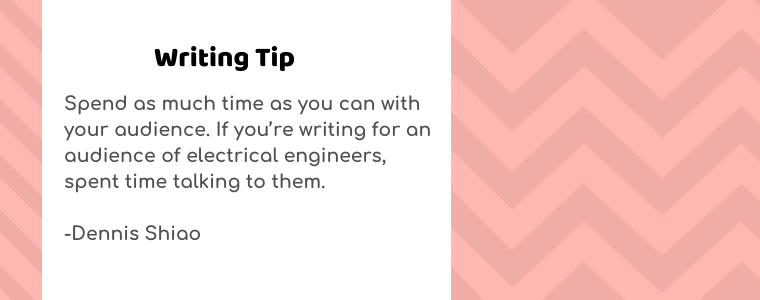 2. Pull up an audience persona before writing
2. Pull up an audience persona before writing
The Content Marketing Manager at Anthem, Emilie Moreland, agrees with what Dennis suggests. Her number one writing tip for marketers is to, “write for your audience.”
Emilie shares, “I find it useful to pull up a persona on one screen while I’m working on a new piece of content. Then that image is embedded in every word I write. If your brand doesn’t have personas, make that your next project.”
Neglecting this tip isn’t something I’d suggest because like Emilie puts it, “ when you truly understand who you are writing for, the words you use and the way you format them will be more powerful.”
3. Know where your reader is in his/her buyer’s journey
So you’re clear about your audience. Just one more bit — where’s your reader in his buyer’s journey?
Freelance long-form writer for B2B marketing companies, Abass Sahrawi, recommends you know at which stage of the customer journey your reader is.
He notes, “understanding this, you’ll be able to make sure that your writing meets your client’s (or your own brand’s) business goals. Remember, you’re writing an asset not a mere blog post.”
Put simply, this is a million-dollar tip. Because this is what ensures your content encourages readers to take the action your write-up puts in front of them.
4. Imagine writing to one person
So you’ve pulled up a reader’s persona — what next? Copywriter and Content Strategist, Anna Gunning suggests you start oiling the gears of your imagination.
Anna opines, “imagine you’re writing to a specific person (who fits your target audience). It’s much easier to write engaging copy if you think — ‘Jake was the IT guy at my old company, he’s essentially the target audience for this, so I’ll write like I’m speaking directly to Jake.’ That then becomes your litmus test when reviewing your copy.”
Good? Good!
5. Curate all the good stuff you’ll possibly need for your write-ups
Have you ever been in a situation when it takes you hours just to get ahold of that stat or infographic you saw somewhere but can’t remember where? Content Marketing Consultant, Erika Heald, has just the solution for this.
She proposes, “ Always be curating. I have a notebook in Evernote where I clip and keep articles and data visualizations that I think I might want to cite in a future piece of content, and add tags to make it easy to find later.
‘While I do still use search to find statistics and sources for my content, I absolutely always start with my content curation notebook because I know it’s very likely to have exactly what I’m looking for, from a source I’ve already vetted,” continues Erika.
6. Ask yourself, what’s the one thing the reader will learn?
Christina Pashialis, the Content Marketing Manager at Soldo, brings another awesome tip to the table as she says, “ note ‘what’s the ONE thing the reader will learn from this piece of content?’ at the top of your doc so it’s always top of mind throughout the writing process.”
Two things happen when you jot down your main takeaway. One, the takeaway becomes clear to you. Two, having it right in front of your eyes means you’ll see it every time you work on the piece, leaving little risk of you deviating from it.
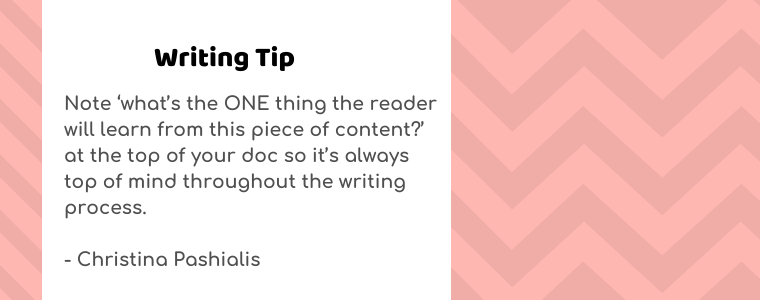 7. Build in some ‘thinking’ time
7. Build in some ‘thinking’ time
Freelance SEO Writer, Annie Thorpe says, “build in thinking time to your schedule. You might be able to physically research and write 500 words in a morning, but will it be good if you’ve not had time to cogitate? Probably not.”
Thinking time lets you replay info you have on a topic and work out different ways to write the piece.
8. Lay out an outline
An outline gives your direction. Working on a piece without it is more a writer’s mindless goose chase for the perfect piece.
No wonder Christina Pashialis shares preparing an outline as another important tip. She explains, “ Map out the structure of a piece before you start ‘properly’ writing it, i.e., list out the different sections with subheadings and bullet points of what should be covered in each part. Add links to relevant reference materials.”
“Having this skeleton in place means you can then dive into whichever sections you fancy writing most instead of beginning with a scary blank page. I find this approach helps with writer’s block and keeping a succinct story in place.”
So, it makes sense to lay out your write-up with all the small details before you flesh it out.
9. Dig into research
Fintech Writer, André Spiteri emphasizes on research. A lot of it. He says, “I find that when I know the topic inside out and have an idea of the structure beforehand, it’s easier to write.”
So what’s the one way you can learn the topic inside out? Research. André adds, “ research as much as you can ahead of time and be absolutely clear about the main point you want to get across.”
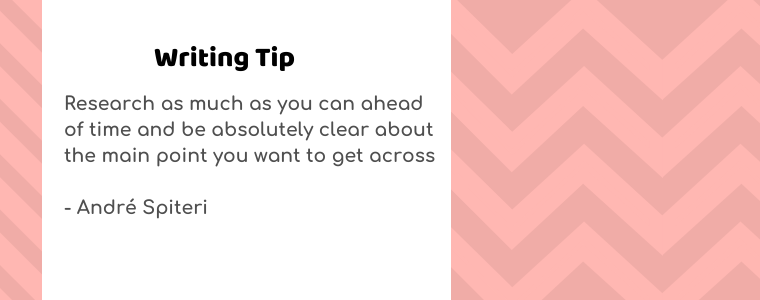 10. Nail the tone of voice
10. Nail the tone of voice
While you’re researching, make sure you take the time to understand your brand’s (or the brand you’re writing for) tone of voice as Fintech Copy and Content Writer, Joe Jones proposes.
Joe elaborates, “Ask as many questions about the tone of voice (ToV) as you can. It’s often under-appreciated, but it’s significance is immense because the tone of voice decides how you put words into a piece.”
Visit your brand’s style guide and remind yourself about the tone of voice every time you start working on a new post. Check out previous blog posts too — this helps give your memory a good kick.
If you’re only starting out and don’t have a refined ToV, Joe recommends, “you look for examples of writing you want to emulate or use them as a guide. This always seems to work quite nicely.”
11. Don’t expect yourself to be an expert
Closely related to André’s tip is Fi Shailes’s tip. Fi is the Editor of Digital Drum and she thinks its best you keep reasonable expectations from yourself.
In her words, “ ‘don’t expect to be an expert at everything’ when it comes to writing about different subject matters. It’s ok to look things up and do a bit of reading around/seeing what’s already out there, rather than feeling a pressure to have all the answers straight away. Thank God for Google.”
Writing tips for when the just words don’t come12. Start with gathering raw material
Devon Delfino, an independent journalist, puts things honestly. She says, “if you’re having trouble starting a piece, try information gathering instead. Add anything that seems relevant to your document, whether that’s fact-checking information or a random memory that you want to form an essay around.”
Doing so will help you work on the piece you just can’t seem to write without feeling guilty. Or, like Delfino, puts it, “you can ‘avoid’ the writing part (and the blank page) while still getting something done.”
Voila!
13. Just start writing
Undeniably, this is “one of the best pieces of advice for writers — just start” in the words of Writer and PR Consultant, Michelle Garrett. And, I can’t agree more.
Michelle warns, “ If you wait until you’re ‘ready’ to write, it may not happen. Just put pen to paper (or get behind the keyboard) and go for it. Remember, the first draft doesn’t need to be perfect.”
But what if the voice inside your head plants seeds of doubts? Read on. The next writing tip will help you with just that.
14. Or start wherever you’re comfortable
Freelance writer, Dee says, “start where you feel comfortable.” Dee thinks, “there’s no rule that says you have to write the intro first — unless of course that’s what the client wants otherwise, build your content in the way that suits you and the way your brain works.”
Travel Writer, Kelly Dunning, works the same way as Dee does. In fact, she always writes the intro last. Why? Because she thinks, “it makes sense that way. Otherwise, you’re writing an intro to an article that doesn’t exist yet.”
15. Tell your internal editor to shut up
“Unless you rein in your internal editor, it’s easy to get stuck in a cycle of self-doubt and procrastination as your deadlines loom closer and closer. This leads to panic, which only further immobilizes you,” says Jennifer Bridges.
Jennifer is the Content Marketing Manager at ReputationDefender who shares self-doubt can be crippling. So her honest advice is to, “tell your internal editor to just ‘shut up.’”
She goes on, “ Once you give yourself permission to release the words onto the screen, the rest is easy. No matter how bad your writing is, you can always go back and rework it later. The key is to pull the plug and let your thoughts start flowing in the first place.”
16. Start copying your favorite article. Literally
This one’s a fun one. It comes from Freelance SaaS Marketer and SEO, Michael Keenan, who advises, “To get ‘unstuck’, go to your favorite publication with a tone and style that matches your client’s — for example, mine’s NNG Group — and start typing up one of their articles in a doc.”
Michael explains, “rewriting their words helps loosen up your brain and reignite the writing voice inside your head. It can take all of 15–20 minutes and get you back on track to write more. Plus, if it’s an article you’ve never read before, you’ll also learn something new in the meantime — double win!”
So who’s trying this tip when the words don’t come and your deadline is just around the corner? 🙋
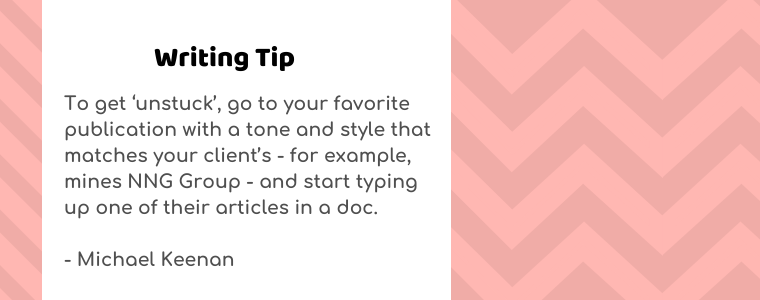 17. Gather all the inspiration you can
17. Gather all the inspiration you can
Una Dabiero, the Editorial Associate over at Fairygodboss, the largest online career community for women says, “I find my best writing happens when I keep myself inspired.”
So her writing tip for us involves being inspired before cranking out those words. She tells, “I usually oscillate between periods of production and periods of just taking in everything around me. During these more meditative periods of time, I alleviate pressures I have to produce, read everything I can get my hands on, and study why they do or don’t work. I also watch a lot of TV and film, seek out art, and note interesting conversations I have.”
Question now is, how do you inspire yourself before you write?
18. Read. Read. Read
Turns out, I’m not alone when it comes to reading for inspiration and learning. Freelance Content Marketing Writer, Kristen Austin, shares my approach. She recommends, “Read-a lot, and widely.”
Kristen explains, “The best way to improve your understanding of language and what good sentences look and sound like is to be a voracious reader. And while that definitely includes reading blog posts, books, and other resources in the topic areas you write about (you have to know what you’re talking about to write well about it), don’t stop there.”
Reading fiction and outside your industry also helps. “Not only will absorbing all those words and sentences help you create better sentences yourself, but you’ll also be taking in lots of ideas that will make you a better thinker. Which absolutely makes you a better writer.”
19. Show your draft the bin
Direct-response Copywriter and Founder of All Good Copy, Glenn Fisher has another effective writing tip for you.
He points out, “If you’re ever not sure whether something you’ve written is any good, read it aloud once and then scrap the whole thing. Don’t save it. Just bin it. Delete. Gone.”
What? You read that right.

Glenn outlines the next step, “Then try to write it again immediately. Whatever you can remember is worth keeping. Take the time to craft it into an entertaining and valuable piece. Good riddance to the rest. If you’re feeling particularly daring — and want to write really good stuff — use this same process with work you thought was quite good in the first place.”
Writing tips for marketers for when you actually get down to writing20. Your introduction doesn’t need to come in first
Introductions are pesky, little bugs that can slow you down. Heck, intros can even prevent you from getting started in the first place. This is why podcaster, blogger, and a side project aficionado, Ryan Robinson, thinks you need to, “write the most energizing sections of your content first.”
Robinson notes it’s a common misconception that writers, “need to write their entire article, case study, eBook or otherwise in a continuous path from introduction all the way through to conclusion.”
“In my experience,” Ryan continues, “that’s rarely the best way to create a transformational piece of content. There’s usually a particular subsection (or two, three, four) that I find most energizing to write about when I sit down to craft a new in-depth article for my blog.
This means I almost always write my introduction and conclusion last, which makes more sense to me, as it’s only after writing an entire piece of content that I can properly introduce the reader and eventually send them off with a compelling call to action at the end.”
21. Don’t work at your piece all at once
Maddy Osman, SEO Content Strategist at The Blogsmith, has another incredible tip, “Outline, write, and edit at three separate occasions to come to the process with a fresh perspective.”
It’s something I do myself! 🙌
Maddy elaborates, “Never set aside time to write if all you have is a blank page. Take notes leading up to a writing session so that you can hit the ground running. When editing, don’t try to edit for everything at once. Focus on doing a pass to fact check, to fix formatting, to ensure proper spelling/grammar, and so on. Read your work out loud to bring any awkward phrasing to light.”
22. Be conversational
Kristen Austin who shared reading as her number one writing tip has another favorite (and very useful) tip as well. She points out, “Be conversational. Unless you’re writing academic texts, you don’t want your reader to feel like they’re doing work.”
And it’s not just that, Kristen adds, “using conversational language makes what you’re reading more interesting, which makes readers more likely to stick with. And it will make them feel more connected to you, and more likely to come back and hear (read) more of what you have to say.”
Be more conversational in your writing by using contractions, asking questions, keeping your sentences short, employing simple language. Want more cool tips? Read on to see what James and Sagan suggest next.
23. Record yourself
James Tennant, Founder at Converge and an awesome writer himself lays out, “my number one writing tip is to take some time to record yourself reading your article out loud when you think you’ve finished it, and listen back.”
Recording yourself helps you pick out jargon and stiff writing that doesn’t talk to the reader. James elaborates, “nothing will reveal stilted, overly formal language faster than this. Doing this is a great way to ensure your article is hitting the right tone of voice and is as readable and engaging as possible.”
24. Use plain language
Writer and Romance Novelist, Sagan Morrow has another tip for making your writing more conversational and getting your draft down. She points out, “ use plain language, don’t overthink it, and write from the heart. It’s about getting it done, not perfect… and to remember that it can always be edited in the future.”
Arfa, the face behind She Means Blogging, also emphasizes on using plain language. She proposes our, “focus should be to gauge reader’s interest by choosing words they relate [to] and understand.”
What’s more, Sagan thinks, “it’s so much about being true to the message you want to convey.” For marketers, this translates into knowing your subject well and having hands-on experience about what you’re talking about.
25. Ask yourself: why would your reader care?
Remember Dennis and Emilie’s writing tips? They wanted you to focus on understanding your audience.
And content marketing freelancer and my dear, kind-hearted friend, Andra Zaharia’s tip ties in well here as she suggests you ask yourself, “why would the reader care?”
It’s something Andra does herself. She adds, “When I write or edit, I always keep this question in the back of my mind: why would the reader care? It sounds simple, silly even, but it helps me avoid fluff, it makes it easier to choose supporting arguments and examples, and to add nuance.”
26. And: what would your reader want to know?
In my view, this question is what leads to the birth of in-depth pieces that answer all questions that readers could have. Copywriter for Small Businesses and Entrepreneurs, Jen Phillips April, insists you ask yourself, “ what does your reader want to know? What benefits they’ll get from reading?”
To complement your thinking here, head over to Google and look at the related searches at the bottom of the page and the ‘People also ask’ section to make sure you’re addressing each question your reader has.
Finding all this too tedious? Head over to Answer The Public and learn what searchers are looking for by simply entering your keyword.
Lastly, as you plan your piece, ask yourself another question, “what do you want them to do next?” This helps you include a call-to-action (CTA) to your post that helps you meet your content marketing objectives.
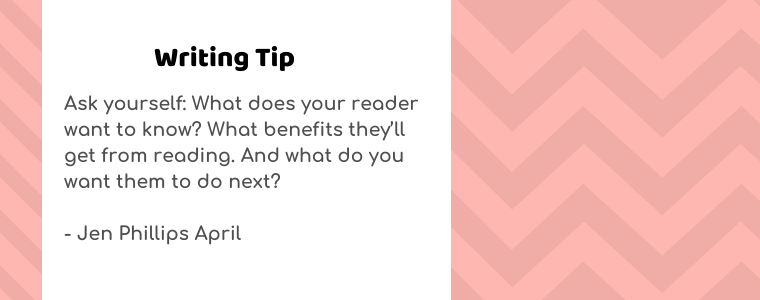 Writing tips for when you’ve written your copy27. Cut your intro
Writing tips for when you’ve written your copy27. Cut your intro
Introductions are tough to write. And it’s a truth almost everyone who has ever attempted to write something is aware of. SaaS Writer, Marijana Kay, has a brilliant suggestion here, “ Cut your blog post introduction! “
She details, “Often times, introductions are too vague and don’t paint a clear enough picture of the pain point the blog post is addressing. The a-ha moment is usually hidden two or three paragraphs in.
‘Remove the first sentence of your blog post and see if the intro still makes sense. If it does, cut another one, and keep going until your introduction strikes an essential point that will draw the reader in. Works like a charm!”
28. Delete half your draft
Hiba Amin, the Content Marketing Manager at SoapBox has another tip that’s similar to Glenn’s. Hiba shares a tip that her manager gave here, “ When you think you’ve written something great, delete it and use half the words.”
Whether you realize it or not, but if you rewrite your drafts to polish and tighten them, you actually chop out nearly half the words.
I know because I’ve tried it myself. After all, think of the beauty you’d create just be mercilessly pruning your work.
29. Make your content readable
Copywriter at That. Content. Shed., Gareth Hancock proposes you, “please the eyes first, then engage the mind.”
In other words, you make your write-up easy to read — not only for your reader (who comes later in the process) but for yourself too so you can edit the piece properly.
Gareth goes on, “ make your writing attractive to look at by using plenty of white space. Write in short paragraphs and use subheadings and bullet points to make information easy to find for skim readers. “
I’ve now gotten into the practice of writing short paragraphs as I go. Even so, before editing my first draft, I’ll always make sure it’s pleasing to the eye so I can work on it. Like Gareth puts it, “if your work looks easy to digest, people are more likely to commit to reading it.”
30. Read your subheadings only
Gill Andrews, Conversion Copywriter and Web Consultant, shares an excellent tip you wouldn’t have thought of. And it relates with subheadings.
Gill suggests read only the subheads of your piece after you’ve written your article. At this point, ask yourself, “Is it still worthwhile for your visitors to read the actual text? Or can they learn everything there is to learn just from those bold lines?
If it’s the latter, congrats, you just wrote the ‘X obvious things about Y everyone knows already (but hey, it’s beautifully formatted)’ post.”
Put simply, Gill recommends you work on writing subheadings that are clear but intriguing.
In her words, “clear section headings are a good thing. But if they give away everything there is to know about your article, then there wasn’t much value in it in the first place. And there’s no point reading the rest.”
So, what do you do if your subheadings are all too clear? Here’s what Gill suggests you do,
“Make sure you aren’t repeating what everybody else has been saying and add your own perspectiveLook at the topic from an unexpected angleAdd a twist in the headings, still keeping them clearAdd humor and personality”
However, if you can’t make all these changes, go on and pick a different topic for your post.
31. Read your draft backwards
Author and owner of MKS Solutions, a network-based marketing agency, Karlene (Cameron) Swalley, shares a tip to catch typos.
She says, “See your manuscript through fresh eyes — read it backwards! I know this sounds a bit odd, but let me explain. By jumping to the end of your paragraph (or story) and reading each sentence from the bottom up, you’ll be much more likely to catch grammatical errors or holes in your manuscript.”
The thing is, “when we read from the beginning, our brain fills in missing letters or corrects misspellings because our mind is already engaged in the story and making connections. By reading backwards, you are forced to slow down, read more deliberately, and can spot errors you may have originally glossed over” in Karlene’s words.
Freelance writer, Kat Boogard, does the same. She says, “it’s definitely more tedious, but I find it helps my brain catch typos and other tiny errors in each sentence that I otherwise would’ve skipped right over.”
32. Read your work out loud
Head of Content at GatherContent, Robert Mills, also suggests you read your work out loud. He insists, “this might feel awkward but the minute you hear the words, you can catch phrasing, words and structural issues that may have passed you by with proof reading.
‘Sometime we are too close to our writing to be able to review it objectively. This is especially useful if you’re trying to write in a way that’s ‘human’ as if your writing doesn’t sound like how you would say something, it may need refining.”
Robert explains this tip is so valuable they’ve included it in their content style guide at GatherContent. I vouch for it too — reading out loud works wonders!
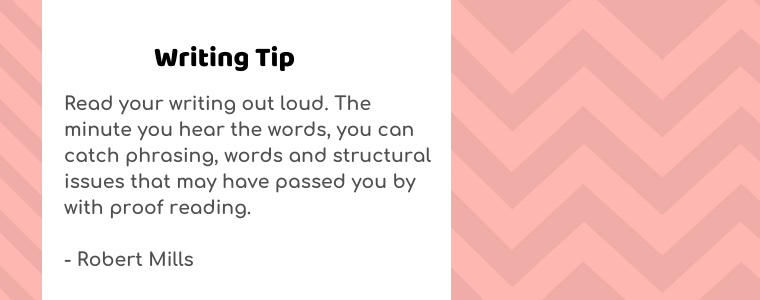 33. Edit in a different font size
33. Edit in a different font size
CIPR-accredited Comms and Copywriting Specialist, Jamie Summerfield, adds another tip here. He suggests you, “ rewrite and edit your copy using different software, or even just a different font and size. “
According to Jamie, this “gives you a different perspective.” So you could write in Microsoft Word, but edit your copy in Google doc. Or, you could switch devices — take down your draft on your desktop, but edit it on your tablet.
Alternatively, change the font size or type of your draft. This will help you see typos and slips that you wouldn’t catch if you go on to edit in the same setting. Why? Because your brain will oversee those mistakes.
34. Let your writing breathe
Megan Rose, copywriter for charities and businesses, has another tip for you. She suggests, “ALWAYS (if time allows) write your draft and then sleep on it. Not literally, but you know what I mean…”
What Megan means is that you need to:
Write a draftLeave it untouched overnight if time allows andGet back to working on it the next day
Jonathan Wilcock, another one of my favorite copywriters, calls this, “the overnight test.” He explains, “No matter how good you think a bit of writing is, take time out from it. In an ideal world, forget it for at least 12 hours. After a good night’s kip, you’ll see those typos, repetitions and clumsy sentences that drag everything down. If time isn’t on your side, at least have a tea break — just don’t hit send before you’ve had the chance to look at things with fresh eyes.”
Aaand that’s a wrap!
If you’ve read this far, I’m honored. Feels like almost two months of work (reaching out to people and putting together this piece) has paid off.
And hats off to you — you’ve read about 5000 words. Woo-hoo
P.S. Which of these is your favorite tip? Share it in the comments below or tweet at me.
Originally published at https://inkandcopy.com on February 20, 2020.
Write Better Today: Steal These No-Nonsense Writing Tips from 30+ Industry Experts was originally published in Marketing And Growth Hacking on Medium, where people are continuing the conversation by highlighting and responding to this story.
Read more: blog.markgrowth.com
